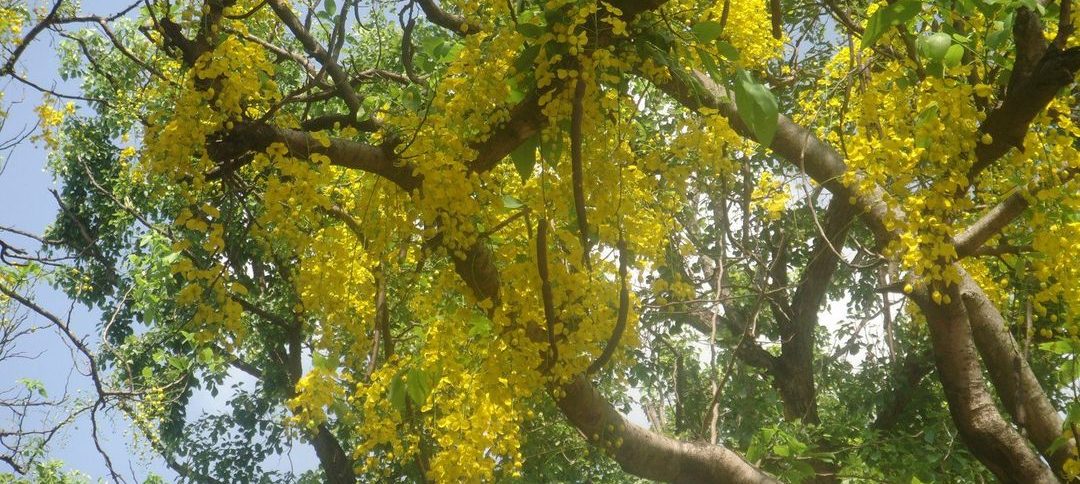INDIAN LABURNUM: Amaltas/Sonari
I wish Bhubaneswar had more flowering trees. I saw a splendid Amaltas at Raj Bhavan roundabout yesterday, the drooping sprays of clear yellow flowers clothing the tree in a mantle of gold. I remember streets in Delhi lined with alternating trees of gulmohar and amaltas and the explosion of colour as summer arrived. Most of the trees do not bloom at Bhubaneswar and its a sad feeling, when you think back of the Bhubaneswar of the 70’s and early 80’s … the explosion of colours during the day time and the swaying trees in the evening telling you that the cool summer breeze is blowing. And sitting outdoors in the evening was the thing to do.
Coming back to the Amaltas tree, this tree is a veritable instance of the ugly duckling turning into a gorgeous swan. This without doubt is one of our loveliest flowering trees. Similar in many ways to the English Laburnum, it is infinitely more beautiful. Each in its season becomes “rich in streaming gold”, but the drooping flower clusters of our trees are many times longer and the individual blooms many times larger than those of their English cousin. The tree when in bloom does not have space for any leaves and it looks like the tree is illuminated. Amaltas blooms in late spring. The flower bunches are pendulous, fragrant and yellow, which attracts bees and butterflies. Each flower has 5 petals and the flower is 4 to 7 cm in diameter. The tree grows up to 35 to 60 feet. The leaves are long, pinnate with 6 – 8 pairs of leaves on a stalk. The fruits are brown long capsules with flat poisonous seeds.
At the beginning of the year the Laburnum is by no means an attractive sight. The long, cylindrical pods appear in profusion and hang like pipes among the nearly leafless branches. They sometimes grow upto 90 cm. in length and contain large numbers of shiny, brown seeds. At first the pods are green and soft; later they turn brown and eventually become black and very hard. The pulp of these pods is used in India to flavour tobacco. Taken in large doses the pulp is a strong purgative, yet bears and monkeys eat it in largesse and with flourish!
The Laburnum is the national flower of Thailand, where it is known as Rachapruek, and its yellow flowers symbolize Thai royalty. In India, the flowers have ritual importance in the Vishu festival of Kerala. The plant, of course, has numerous medicinal benefits and is commonly used in Ayurveda to treat constipation, skin diseases, and inflammations. In fact, Amaltas is the safest laxative to be used in cases of constipation.
Ayurveda recommends the pulp of the pods as laxative and in abdominal and skin diseases.
The fruit pulp with milk is used in liver – spleen diseases, cardiac debility, and leprosy.
The pulp is also recommended as external application in gout, rheumatism, skin diseases and snakebite.
In Ayurveda, the leaves are applied externally for ringworms and other types of infections.
In tribal medicine, the leaves and bark is ground with water and applied externally to cure ringworms, insect bites, facial paralysis and rheumatism.
Ayurveda recommends root paste of amaltas with milk for fever, heart diseases, retained excretions and glandular swellings.
Amaltas is used as a remedy for burns, cancer, constipation, diarrhea, epilepsy, hematuria, pimples, and glandular tumors.
Unani medicine uses the leaves for inflammatory conditions; the flowers as a purgative; and the fruit as anti-inflammatory, abortifacient, chest complaints, heart and liver ailments, and rheumatism.
In the upper Sind, the leaf poultice is applied to chilblains; the plant is also used in facial massage for brain afflictions.
In Far Eastern medicine, the uncooked pulp of the pods is used to treat constipation and prevent kidney stones.
In the West Indies, the pulp and leaves is used as poultice for inflamed liver.







